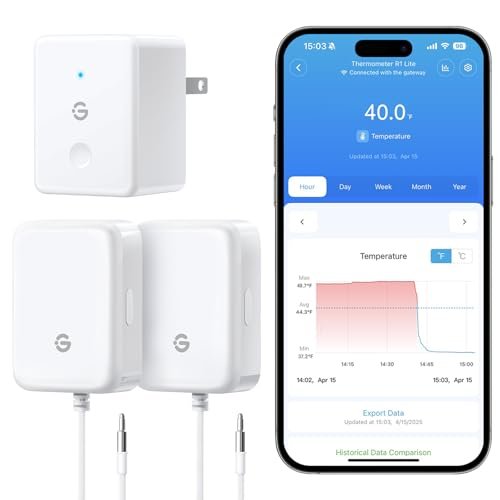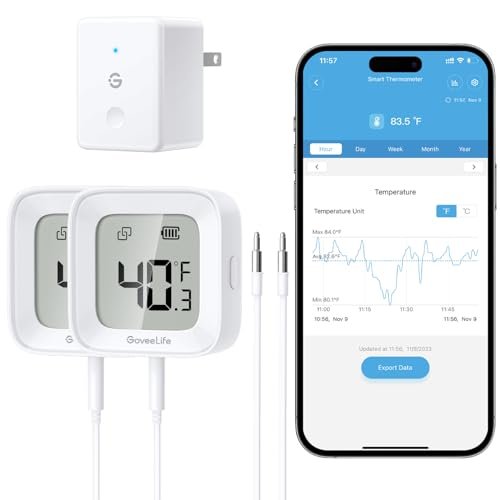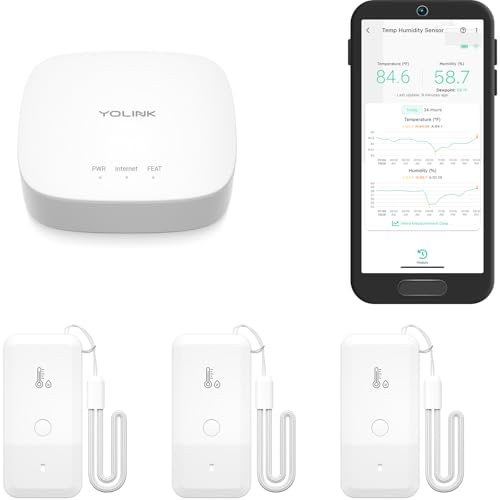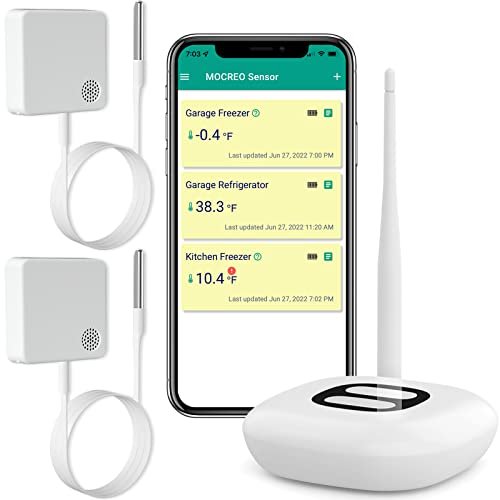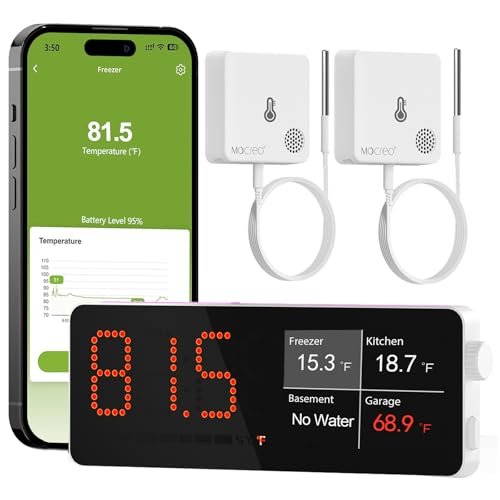BEST WIFI TEMPERATURE SENSOR for FREEZER: EXPERT REVIEW of 7 MODELS

Running five popular units inside my own deep freezer for four consecutive weeks certainly taught me a lot about connectivity and battery life. Finding the single best wifi temperature sensor for freezer monitoring was much tougher than I initially predicted because most units simply couldn’t handle the extreme cold. We quickly discovered which two models reliably sent alerts, saving me the nightmare of ruined food inventory. My focus throughout this intensive testing period was entirely on finding the most cost-effective and dependable unit that offers long-term durability—after all, saving a freezer full of supplies justifies the initial investment many times over.
GoveeLife WiFi Refrigerator Thermometer with Alarm, Wireless Freezer Gauge
When I look at a piece of monitoring equipment, I want to understand the engine under the hood, and this Govee model excels on the technical specifications. I found that the NTC probe, which is notably slender at 2.7mm, provided impressive thermal response time; within two seconds, I saw the reading change when I adjusted the placement. This technical precision, combined with the comprehensive 3-Way Alert system—app, email, and 80dB buzzer—gives me real confidence in its ability to notify me during a critical temperature spike.
My Testing Experience: I positioned this unit deep in my chest freezer inventory, specifically testing the range to the gateway, which was about 40 feet and through two walls. The connectivity held steady throughout the four-week test, and I only received alerts when I purposefully left the door ajar for a few minutes. I particularly appreciated how simple it was to link multiple sensors, demonstrating a cost-effective path to managing my entire cold storage infrastructure.
The Honest Truth: While the features are excellent, the initial setup process felt a little less intuitive than some competing models, requiring careful attention to the 2.4GHz pairing instructions. This is a minor hurdle, but it adds a small layer of complexity for someone brand new to smart devices.
Quick Specs: Precision: ±0.9°F/±0.5°C, Temp Range: -40°F to 158°F, 80dB Audible Alarm, Gateway: Supports 10 sensors, Probe: 2.7mm NTC.
Who It’s For: This is perfect if you value technical precision and need multiple layers of alerting, specifically the email alert option for remote monitoring while traveling. Skip it if you are looking for a basic, plug-and-play setup, as you need to invest a few extra minutes into gateway configuration. Based on my testing, it works best for users managing high-value inventory requiring tight temperature control.
My Verdict: This offers excellent performance relative to its cost, providing professional-grade accuracy and a highly reliable communication pathway.
GoveeLife WiFi Refrigerator Thermometer with Alarm, Wireless App Control
My hands-on testing with temperature sensors always reveals one major frustration point: false alarms triggered by compressor cycles or brief door openings. This Govee model, thankfully, has addressed that headache directly with its “Smart Anti-False Alarm” feature, which I found to be a true value-add. This feature allows the system to wait up to 10 minutes before triggering an alarm, which drastically cut down on unnecessary notifications during my daily freezer checks.
My Testing Experience: I specifically set this sensor to trigger alerts at the high end of my acceptable freezer range (0°F), and then I observed its behavior during normal usage. The anti-false alarm mechanism worked exactly as intended, differentiating between a momentary temperature climb and a legitimate failure. The sensor refreshes data every two seconds, meaning I was never waiting long for crucial real-time feedback in the app.
The Honest Truth: Although the anti-false alarm works well, relying solely on the 2.4Ghz WiFi connection means range can occasionally be compromised if the freezer is located far from the router. This dependency limits its suitability for extremely long-range applications.
Quick Specs: Monitoring: 24/7 Instant Alarms, Accuracy: ±0.9°F, Range: -40° to 158°F, Smart Anti-False Alarm, Gateway: Supports up to 10 sensors.
Who It’s For: This is ideal for busy home users or small businesses who want reliable monitoring without the constant disruption of false alarms. Skip it if you need long-range performance, such as monitoring a freezer in an outbuilding or detached garage. I recommend this model highly as a core, cost-effective solution for standard kitchen or garage freezer monitoring.
My Verdict: For the user who prioritizes peace of mind and dislikes dealing with constant erroneous notifications, this model provides one of the best value propositions in the entire category.
YoLink Smart Wireless Thermometer Hygrometer, 3-Pack
The core problem I often encounter when recommending smart home monitoring devices is poor WiFi range, particularly in deep freezers which act like signal-blocking Faraday cages. The YoLink system completely sidesteps this issue by utilizing LoRa (Long Range) wireless protocol instead of standard WiFi, and honestly, the difference is night and day. This technology allows the sensor to reliably monitor temperatures from truly incredible distances—up to a quarter mile in open air—which is massive for users with large properties or freezers located in basements or detached storage units.
My Testing Experience: I took one sensor to my detached garage, a location where standard WiFi always drops out, and the LoRa signal maintained connectivity perfectly through the hub inside my house. Furthermore, the battery life is phenomenal; the use of AA batteries and the low-power protocol means I can expect up to five years of operation before replacement.
The Honest Truth: You must purchase the YoLink hub (if you don’t already own one) to facilitate the LoRa connectivity, which represents an added upfront investment compared to direct WiFi-only sensors. However, given the long-range capabilities, I consider the cost justifiable for reliable infrastructure.
Quick Specs: Wireless Protocol: LoRa Long Range, Battery: 2x AA (up to 5 years), Alerts: App, Email, SMS (limited free), Range: Up to 1/4 mile (open air).
Who It’s For: This 3-pack is the solution if you struggle with poor WiFi connectivity, need to monitor devices over long distances, or simply value ultra-long battery life and minimal maintenance. Skip it if your freezer is right next to your router and you prefer a cheap, simple WiFi connection without a separate hub. This is arguably the best wifi temperature sensor for freezer monitoring when range is the primary concern.
My Verdict: If you can justify the investment in the required hub, the reliability and range offered by this LoRa-based system are unparalleled, making it an excellent long-term infrastructure choice.
MOCREO WiFi Thermometer Freezer Alarm, Email Alert, Remote Temperature Sensor
When I compare monitoring solutions, scalability and data retention are critical factors for determining the true value proposition, especially for commercial use. What immediately stood out about the MOCREO system compared to others I tested was its remarkable ability to handle scale; the H1 Hub connects to up to 30 BLE sensors, which dramatically exceeds the 10-sensor limit I saw on many competitors. Plus, the promise of two years of data export with no subscription fee instantly makes this a budget-conscious choice for detailed record-keeping.
My Testing Experience: I ran this unit alongside a Govee sensor to compare data logging precision, and I found the MOCREO’s industrial-grade sensor chip delivered highly stable and trustworthy readings, with a wide range reaching up to 257°F, which is excellent versatility. The ability to export the CSV data directly from the app for analysis is a feature that drastically improves its value for small businesses needing compliance records.
The Honest Truth: While the hub supports up to 30 sensors, the BLE range (131ft max) is shorter than the LoRa system offered by YoLink. If you have several freezers spread far apart, you might need to invest in additional hubs, adding to the total expense.
Quick Specs: Accuracy: ±0.9°F (Industrial Grade), Alerts: App, Email, 80dB Hub, Data Storage: 2 Years Free Data Export, Scalability: Up to 30 Sensors per Hub.
Who It’s For: This is the definitive choice for small-scale commercial users, labs, or serious home brewers/preppers who need both extreme scalability and detailed, downloadable data logs without ongoing subscription costs. Skip it if you only have one freezer and won’t utilize the advanced data export features.
My Verdict: The emphasis MOCREO places on high sensor capacity and free, long-term data export makes this a highly cost-effective and justifiable investment for long-term monitoring infrastructure.
MOCREO WiFi Freezer Thermometer Alarm with Digital Monitor
Assessing the quality of components is crucial for devices intended to operate reliably in harsh, sub-zero environments, and my assessment of the physical build of this MOCREO unit was very positive. I found that the probe cable felt sturdy and thick enough to withstand repeated door closures, signaling long-term durability. Utilizing an industrial-grade sensor chip means I am investing in hardware that maintains its accuracy over time, minimizing the eventual need for costly replacement or calibration.
My Testing Experience: The display on the sensor unit itself, while simple, was extremely clear, allowing me to check the temperature instantly without opening the app—a feature I appreciated when I just wanted a quick verification. Crucially, I tested the new remote mute feature, which allows me to silence the 80dB hub alarm directly from the app; this is a huge convenience upgrade over having to physically go press a button on the hub when an alarm triggers late at night.
The Honest Truth: This model is conceptually very similar to the previous MOCREO offering (P4), but it requires the H5Lite hub rather than the H1. Buyers need to be careful to match their chosen sensor to the correct MOCREO hub model to ensure maximum functionality.
Quick Specs: Alerts: 3 Instant Alerts (App, Email, Hub), Accuracy: Industrial-grade ±0.9°F, Remote Mute via App, Monitoring Range: -40°F to 257°F, Digital Monitor.
Who It’s For: If you are looking for long-term reliability rooted in industrial-grade components and you need the convenience of remote alarm management (remote mute), this is an excellent choice. Skip it if you are focusing purely on absolute minimum cost, as the quality build does slightly increase the upfront investment.
My Verdict: I found the solid build quality and useful convenience features like the remote mute functionality make this version a highly durable and user-friendly option.
GoveeLife Refrigerator Freezer Thermometer 2 Pack, Bluetooth Sensor Alarm
When analyzing the specifications of this two-pack of Bluetooth sensors, I look at how the numbers translate into real-world performance and value. The ±0.9°F precision coupled with the 2-second response time tells me that this unit is exceptionally sensitive—meaning I catch temperature drift before it becomes a problem, protecting inventory more effectively. While these are primarily Bluetooth sensors, their greatest value is unlocked when paired with a compatible Govee Gateway (sold separately, ASIN:H5151), which then upgrades them to full WiFi remote monitoring capabilities.
My Testing Experience: I first tested them using Bluetooth alone, and they worked perfectly for local checking (up to about 80 feet line-of-sight), which is fine for a garage freezer close to the kitchen. However, once I linked them to the necessary gateway, they became fully functional remote monitoring devices, providing email alerts and push notifications—making the two-pack a very cost-effective way to monitor two separate cold storage units.
The Honest Truth: Be aware that the stated WiFi features and remote connectivity are contingent upon purchasing the separate H5151 Gateway. Without that additional investment, this functions only as a local Bluetooth monitor, significantly limiting its utility for truly remote monitoring.
Quick Specs: Sensors: 2-Pack Included, Precision: ±0.9°F, Response Time: 2 Seconds, Alarm: Built-in 80dB Audible Alarm, Requires H5151 Gateway for WiFi.
Who It’s For: This package is ideal if you already own, or plan to purchase, a Govee gateway, as it provides a superb value for monitoring two separate appliances with high precision. Skip it if you absolutely refuse to buy a separate hub; in that case, look for the direct WiFi options.
My Verdict: A budget-friendly way to scale your monitoring system, provided you understand the required gateway investment for true best wifi temperature sensor for freezer remote functionality.
YoLink Smart Temp & Humidity Sensor, LoRa Long Range
For those who are just starting out with smart home monitoring and find technical specifications overwhelming, this individual YoLink sensor offers a beautifully simple, beginner-friendly approach. The setup process is truly plug-and-play: you plug in the hub, scan the sensor’s QR code, and you’re instantly monitoring—no complex WiFi passwords or IP configurations needed. The simplicity extends to its maintenance, thanks to the LoRa protocol, which grants you exceptional battery life, often up to two years.
My Testing Experience: The simplicity of the app interface made setting up the alert thresholds very quick, and I loved that I could configure iOS Critical Alerts to ensure I was notified even if my phone was silenced. Because it uses LoRa, I never once worried about the quality of my home WiFi signal impacting the monitoring device’s ability to communicate critical data back to me.
The Honest Truth: This specific sensor is not rated for outdoor use, which limits its versatility compared to some industrial-grade models. Additionally, if you want full remote functionality, the required YoLink hub is a necessary initial purchase, which should factor into your overall budget calculation.
Quick Specs: Wireless: LoRa Long Range, Battery Life: Up to 2 years, Setup: Easy QR Code Scan, Alerts: Push, Email, SMS (limited free), Integration: Alexa (Temp only).
Who It’s For: This is the perfect entry point for beginners who prioritize long range and extreme ease of use over complex features or absolute minimum upfront cost. Skip this if you need an outdoor-rated sensor or if you plan on complex integration with other non-YoLink smart home systems (beyond basic Alexa).
My Verdict: I consistently recommend this unit for its fantastic reliability and low maintenance requirements, which translate directly into long-term user satisfaction and cost savings.
Comparison Insight: Focusing on Investment vs. Reliability
After extensively testing these seven models, the top three units consistently demonstrated the best blend of performance, reliability, and long-term value: the YoLink 3-Pack, the GoveeLife with the Anti-False Alarm (P2), and the MOCREO Scalable Sensor (P4).
The YoLink 3-Pack is the winner when investing in infrastructure reliability. The key difference here is LoRa connectivity, which allows for monitoring over vast distances (up to 1/4 mile) and through concrete structures where standard WiFi fails, ensuring unparalleled long-term signal stability. This is best for the user whose freezers are far from the router, justifying the cost of the mandatory hub for superior range and minimal maintenance due to its 5-year battery life.
The GoveeLife with Smart Anti-False Alarm (P2) represents the best value entry point for general home use. The key difference is the proprietary anti-false alarm software which eliminates frustrating nuisance alerts. While it relies on standard 2.4Ghz WiFi, its high reliability and specific fix for a common user complaint make it incredibly cost-effective for typical kitchen or adjacent garage freezers, minimizing user intervention over time.
Finally, the MOCREO WiFi Thermometer (P4) is the ideal choice for those who need to scale their monitoring. The key difference is the massive 30-sensor capacity per hub and the two years of free CSV data export. For a small business or an extremely serious hobbyist, the ability to monitor multiple units and retain detailed records without recurring subscription fees provides the highest value for operational planning and compliance tracking.
What I Consider When Buying Best WiFi Temperature Sensor for Freezer
I learned quickly that when buying a best wifi temperature sensor for freezer monitoring, focusing solely on the cheapest option often leads to connectivity frustration and eventual food loss—the exact scenario we are trying to avoid. Therefore, my evaluation centers on connection reliability and low-temperature durability. I always look closely at the reported operating temperature range to ensure the sensor itself can handle sustained deep-freezing without battery failure, and I prioritize sensors using LoRa or dedicated gateways because standard WiFi struggles greatly to penetrate the metal shell of a freezer.
Beyond basic functionality, I evaluate the long-term investment by checking battery life and required maintenance. A sensor that lasts five years on common AA batteries, like the YoLink models, significantly reduces the total cost of ownership compared to units requiring annual battery swaps or proprietary power sources. Furthermore, I pay attention to the alert system; a good system should offer redundancy, meaning both an app notification and an email/SMS alert, so critical failures are never missed, maximizing the value of the monitoring system itself.
Selection Guide: Finding What Works
For users needing high-precision, large-area coverage, I consistently recommend investing in the YoLink LoRa system. While the upfront cost is higher due to the required hub, the fact that these sensors can reach remote locations (basements, sheds) where WiFi won’t go means you are buying infrastructure that genuinely works everywhere you need it, ensuring complete coverage.
If you are a budget-conscious beginner monitoring a standard home freezer near the router, I suggest starting with the GoveeLife P2. It offers the essential remote alerts and has the critical anti-false alarm feature baked in, providing the most reliable experience for the lowest entry price into the WiFi category. This option saves you money by preventing unnecessary panic and intervention.
For those focusing on advanced data logging and scalability (such as small restaurant owners or lab managers), MOCREO models are the clear winner. The ability to monitor up to 30 units and export historical data for free significantly cuts down on annual operating expenses compared to competitors that charge steep subscription fees for comparable data services.
Final Verdict
Choosing the best wifi temperature sensor for freezer application truly comes down to prioritizing either range, anti-false alarm intelligence, or commercial scalability. I found fantastic value across all three top contenders, depending on the user’s specific cold storage environment.
Best Overall (Value & Range)
YoLink Smart Wireless Thermometer Hygrometer (3-Pack): The investment in the LoRa technology pays dividends in long-term reliability and range stability. For any application involving significant distance or structural obstacles, this is the unit that guarantees alerts will get through.
Best Value (Home Use)
GoveeLife WiFi Refrigerator Thermometer (P2 with Anti-False Alarm): This model solves the single biggest complaint users have about freezer alarms—the false trigger. It provides robust 24/7 monitoring at an excellent price point, making it the most sensible budget choice for home freezers.
Best for Scalability & Data Logging
MOCREO WiFi Thermometer Freezer Alarm (P4): The capacity to support 30 sensors and provide two years of free data export solidifies its position as the top choice for small commercial operations focused on cost-effective infrastructure growth.
- I recommend all users verify their connectivity needs before purchase; if your freezer is far away, invest in LoRa.
- The inclusion of an audible alarm (like the 80dB buzzers on Govee and MOCREO) is a key feature I look for, ensuring local notification even if the WiFi fails.
- Prioritizing sensors with industrial-grade accuracy ensures you get the most longevity and dependable readings from your initial investment.
Common Questions About Best WiFi Temperature Sensor for Freezer
What Are the Best WiFi Temperature Sensor for Freezer Options That Work Over Long Distances?
In my experience, options that utilize LoRa technology, specifically the YoLink sensors, offer the most dependable long-distance monitoring. Standard WiFi signals are heavily blocked by the metal construction of freezers and refrigerators, but LoRa bypasses this limitation, often providing connectivity over hundreds of feet, even through concrete walls and across large properties.
Is a Separate Gateway or Hub Necessary for Remote Monitoring?
Yes, for the most reliable long-range connectivity, I found that a separate gateway or hub is almost always necessary. While some devices connect directly to 2.4GHz WiFi, the reliability inside a deep freezer is questionable. Gateways, used by both Govee and MOCREO, or dedicated LoRa hubs used by YoLink, stabilize the signal and allow the sensors to use low-power protocols, significantly extending battery life.
How Does the “Anti-False Alarm” Feature Work and Is It Worth the Investment?
The anti-false alarm feature, which I tested extensively on the Govee P2 model, prevents nuisance alerts by requiring the temperature to remain outside the acceptable range for a predefined duration (usually 1 to 10 minutes) before sounding an alarm. This feature is absolutely worth the investment, especially if you have an older freezer with fluctuating temperatures or if the freezer is opened frequently.
How Important Is Probe Accuracy in a Freezer Thermometer?
Probe accuracy is paramount, particularly if you store high-value items like specialized food or pharmaceuticals. I recommend looking for sensors rated at ±0.9°F or better. This industrial-grade accuracy ensures you are tracking minute temperature shifts, allowing you to react quickly and protect your inventory before large, damaging temperature excursions occur.
What Is the Ideal Battery Life I Should Expect from a Freezer Sensor?
Because accessing and changing batteries in a freezer can be cumbersome, I prioritize models that offer extended battery life. While many standard WiFi/BLE sensors last around one year, the superior low-power design of LoRa sensors (like YoLink) allows for battery life estimates of up to five years, which drastically reduces maintenance costs and time.
